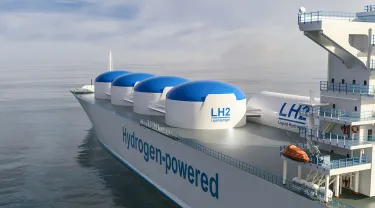Maritime shipping, which powers massive freighters and container ships, produces 5% to 7% of the world’s carbon emissions. Reducing the industry’s impact would make an enormous difference in efforts to shrink the global carbon footprint.
However, the complexity of the industry, its international nature, and the technological and logistical obstacles to reducing reliance on fossil fuels present significant challenges—ones that require the input of experts with specialized knowledge and skills.
Enter Rocky Weitz, professor of practice in maritime studies and director of the Maritime Studies Program at the Fletcher School of Law and Diplomacy (and a Fletcher School graduate himself).
Clean, sustainable fuel—“green fuel”—can be made through a fairly simple process, Weitz said. “Essentially, you take water—either fresh or salt water—and you use electrolysis to break it down into its component parts,” he explained. “The oxygen goes out into the atmosphere and is good for us living things. To the remaining hydrogen, you add nitrogen, which is conveniently the most abundant element in the air. The result is ammonia, and if you carry out the process with electricity produced using clean energy, then it’s green ammonia.”
What’s trickier, Weitz noted, is developing a new value chain that serves green-fuel ships, replacing the value chain that has existed for a century to serve fossil-fuel ones.
But he and a team he’s working with, including colleagues in engineering and chemistry, have come up with an innovative solution.
“In the Aleutian Islands off the coast of Alaska, the wind blows 365 days a year, 24/7. Let’s build a huge wind farm there. Put in 1,000 turbines—you have to think big. Connect the turbines to an undersea grid that comes up to a floating electrolyzer. You have an almost unending supply of water there in the North Pacific. Get the hydrogen from the water in an electrolysis process, convert it to ammonia, and store it right there, because—and this is the beauty of the whole thing—the Aleutian Islands lie right along a major shipping route.”
In other words, ships could stop to refuel in the same location where the green ammonia is produced. Moreover, the plan includes a strategy to seamlessly ship excess green fuel to other industries, contributing to an overall reduction in fossil-fuel dependence.
“What I really love about this idea,” said Weitz, “is that it’s an interdisciplinary, international, cross-industry endeavor—and it’s realistic. It tackles a global-scale problem in a meaningful way.”
